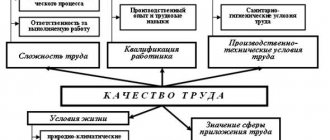Legal provisions establish that employers are required to pay all employees the money they earn at intervals of no more than 15 days. This procedure assumes that, in addition to the main payment for the period worked, employees must also be given an advance.
The Labor Code does not provide clear guidance on the amount of advance payment required, and theoretically, employers must decide this issue themselves.
To solve the problem of calculating an advance payment, you need to understand the procedure for forming this payment and know what the minimum and maximum amounts that the employer must pay are.
Frequency of payment
Each organization sets its own set of rules that apply to all employees. This set of rules is enshrined in local documentation, such as a collective agreement, regulations on wages and bonuses, etc. And although internal relations are regulated between employer and employee, with the participation of the trade union committee, they are primarily based on state legislative norms.
As for the amount and frequency of remuneration, there are clear restrictions, which the employer does not have the right to reduce, but can increase at his own discretion. Regarding the frequency of payments, the Labor Code of the Russian Federation has clear instructions that the interval between cash payments cannot be more than 15 calendar days. But you can make it smaller without any problems. Thus, the management of the organization can initiate payment three times a month or even divide it into weekly payments; such an approach will not be considered a violation.
Legislative regulation
The legislation on the need to charge an advance is stated in Article 136 of the Labor Code of the Russian Federation. It refers solely to the fact that there is a need to divide payments into two times. There is no indication of the size of this or that part.
Meanwhile, both employers and employees have many questions about this. It’s not entirely clear where to start when determining the size. Some consider the amounts for the days actually worked, others simply consider the advance as a certain percentage of the established salary. As practice shows, all methods have supporters and opponents, which leads to the need for legislative regulation.
The Ministry of Labor offers such clarifications in letter No. 14-1/B-725 dated 08/10/17. In 2021, you can safely follow the recommendations of the Ministry of Labor, although they should not be considered a mandatory legislative norm.
How are wages paid?
Chapters are devoted to issues related to wages, such as their establishment, procedure, terms of payment, the procedure for making deductions from them, and the like.
21 of the Labor Code of the Russian Federation (hereinafter referred to as the Labor Code of the Russian Federation). The specific rules for payment of wages are contained in Art. 136 of the Labor Code of the Russian Federation, its main provisions are as follows:
- The employer must notify each employee of the amount of earnings with each payment of wages. To do this, a payslip is generated, which is given to the employee or sent to him by email (read more about this here: When is a payslip issued?).
- The salary is transferred directly to the employee at his place of work or to his account in a credit institution (another method of payment may be established by law or an employment contract).
- Salaries are paid at least every six months; specific payment dates are prescribed in a local act or labor (collective) agreement. It is impossible to replace the payment date with a time interval (clause 3 of the letter of the Ministry of Labor of the Russian Federation dated November 28, 2013 No. 14-2-242).
Thus, wages are paid at least 2 times a month, less often possible only for certain categories of workers, as determined by the legislator. There are no restrictions on more frequent payments.
Concept of advance payments
Let’s define what a salary advance is. Such a concept as an advance payment cannot be found in any article of the Labor Code. In the Labor Code it is prescribed as part of the salary, but it is generally accepted to call the early payment of part of the salary an advance accrual.
An advance is a salary for the first half of the month, which is paid before the billing period comes to an end and final accruals are made.
Most often, employers used the approach of accruing 40% of the salary on the day of the due prepayment. But this approach is not always correct, because wages consist not only of the established salary or tariff rate, but also increasing factors, additional payments, bonuses, and so on. All these indicators should be taken into account in advance payments.
Amount of salary advance
Until 2021, the advance as a percentage of salary was completely different. Most often it was 40 percent, this ratio was determined by the following calculations:
- Half of the time worked implies 50% payment.
- 10 percent was subtracted from 50% as an approximate amount for taxes.
This generally accepted practice may actually be considered a violation of the law, as was clarified last year by the Ministry of Labor. In accordance with letter of the Ministry of Labor No. 14-1/B-725 dated August 10, 2017, the advance amount must correspond to the time actually worked on the day the money was issued. The calculation must take into account not only the amount of salary or tariff rate, but also other allowances due to the employee in accordance with the employment contract. The advance payment also includes amounts for part-time work, overtime hours worked, and night work.
Some amounts, however, should not be taken into account when calculating this amount. The Ministry of Labor says that the use of regional coefficients in relation to advance payments is fundamentally incorrect. The fact is that regional coefficients are calculated based on the final payment for the period worked and it is incorrect to calculate it earlier. Also, bonus amounts are not included in the interim payment, since a bonus can only be paid upon the completion of a certain period and based on the results of the work performed. The bonus is not a mandatory amount; it may or may not be accrued, and even if it is accrued, the amount is determined on an individual basis.
Main Differences Between Advance and Salary
Having studied the regulatory framework, we can conclude that the advance is part of the payment for labor, its indispensable component. This payment is required by the employer. However, there are differences between these funds. They are presented in the table below
| Criteria | Prepaid expense | Wage |
| Deadlines for transferring money | Second half of the month. Part of the salary is paid for the 2 weeks worked | Calculation for a fully worked month, payment at the beginning of the next |
| Tax withholding | No | 13% of the final amount |
| Accrual methods | Fixed amount. percentage of salary or rate. in proportion to time worked | Payment of a specified amount (salary or rate) less advance and withholding of income taxes |
| Frequency of transfers | There are no restrictions, you can issue at least every week | Final amounts are calculated at the end of the month |
Advance and salary are mandatory payments to all employees . The employer is responsible for the modernity and correctness of the transfers. Delay in transferring funds for more than a day is subject to compensation. It is calculated at 1/300 of the refinancing rate in force at the Central Bank on that day. In this case, the organization or responsible person may face a financial fine.
FinanceComment
Deadline for payment of advance payment and salary
Article 136 of the Labor Code of the Russian Federation states that specific dates for the distribution of funds to employees are established separately by each organization.
Information about payment dates established at enterprises is recorded in:
- collective agreement;
- salary regulations;
- internal labor regulations.
In addition to local regulations, each employee, when concluding an employment relationship, is given this information in the employment contract.
The Labor Code of the Russian Federation does not talk about accrual dates, but only establishes a gap between them of no more than 15 days. But some clarifications on the timing are set out in another document - letter of the Ministry of Labor of Russia No. 14-1/B-911 dated September 21, 2016. It provides restrictions on payments in relation to calendar periods. Salaries at the request of the Ministry of Labor must be transferred on any date, starting from the 1st of the month and ending on the 15th. But the advance payment must fall between the 16th and 30th/31st of each month. It is not recommended to make payments on deadlines, as this is fraught with some complications associated with postponing personal income tax payments.
Calculation of advance payment as a percentage of salary
Labor inspectors are not against an advance as a percentage of the salary for the first half of the month. The first half of the month should be understood as the period of time from the 1st to the 15th (letter of the Ministry of Labor dated September 21, 2016 No. 14-1/B-911).
Why choose an advance amount of 40% of salary
Salaries for each half of the month should be approximately equal amounts, excluding bonuses (letter of the Ministry of Health and Social Development of Russia dated February 25, 2009 No. 22-2-709). To meet these requirements, companies set the advance amount to 50% of salary. What is the result, comments Elena Vyacheslavovna Vorobyova, member of the Scientific Expert Council of the Chamber of Tax Consultants of the Russian Federation, Ph.D. econ. Sciences: “Let’s assume that the salary is 20,000 rubles. There are 20 working days in a month (10 working days + 10 working days). If the advance is 50% of the salary, then: - advance 10,000 rubles. (RUB 20,000 x 50%); — to be paid for the second half of 7400 rubles. (20,000 rubles - 2600 rubles (personal income tax) - 10,000 rubles (advance). If the advance is 40% of the salary, then: - advance 8,000 rubles (20,000 rubles x 40%); - to be paid for the second half of 9,400 rubles (20,000 rubles – 2,600 rubles (personal income tax) – 8,000 rubles (advance)). The “40% of salary” advance payment option gives more equal payments than “50% of salary”, and is more consistent with the requirement of approximately equal parts of the salary for the first and second half of the month." Please note: an advance payment of 40% of the salary does not exempt the accountant from additional calculations if the employee did not work in full for the first half of the month. The employee receives salary, including for the first half of the month, for work (part. 1, Article 129 of the Labor Code of the Russian Federation). If he did not work, he is not entitled to a salary. For example, an employee from the 1st to the 15th:
- was sick;
- was on vacation;
- went on a business trip;
- skipped
The employee was not working. This means that the company is not required to pay an advance for the first half of the month. If the employee worked part of the days from the 1st to the 15th, then the amount of the advance must be adjusted taking into account the time worked. The personnel officer will inform the accountant which employees did not work all days from the 1st to the 15th. For such employees, the accountant will calculate the advance in proportion to the time worked. This procedure must be specified in the wage regulations or collective agreement.
Example 1
The employee was on vacation some of the days in the first half of the month. The company pays wages for the first half of the month on the 17th. The amount of the advance is 40% of the salary. Salary A.G. Brusnitsyn - 27,200 rubles. The employee was on vacation from February 1 to February 5 and worked 8 working days from February 6 to February 15, 2021. There are 11 working days in the first half of February. How much will the employee receive in advance? Decision On February 17, Brusnitsyn will receive an advance of 7,912.73 rubles. (RUB 27,200 × 40%: 11 work days × 8 work days). So, if you choose the size of the advance between 40% or 50% of the salary, then the first option is more successful. But it is not without its shortcomings.
Problem with personal income tax if the advance is 40% of the salary
An advance of 40% of the salary can lead to the fact that at the end of the month the employee will receive money for the time not worked. This is due to the fact that there are fewer working days on non-working holidays in the first half of January, March, May, June and November than in the second half. We will show the calculation in example 2 below.
Example 2
The employee received an unearned advance: how to calculate personal income tax The company pays the advance on the 16th of the current month, and the salary on the 1st of the next month. The amount of the advance is 40% of the salary. Salary A.G. Brusnitsyn - 27,200 rubles. The employee worked from January 9 to January 13, 2021. I was sick from January 16 to January 31. On January 16, Brusnitsyn received an advance of 10,880 rubles. (RUB 27,200 × 40%). How much did Brusnitsyn earn in January? How to reflect the amount earned in 6-NDFL? Decision Based on the results of January, Brusnitsyn earned 8,000 rubles. (RUB 27,200: 17 working days × 5 working days). The amount is 2880 rubles. (10,880 rubles - 8,000 rubles) the employee did not receive for work. Personal income tax from salary amounted to 1040 rubles. (RUB 8,000 × 13%). Date of receipt of income in the form of wages in the amount of 8,000 rubles. — 01/31/2017. On February 1, when paying wages for January, it is impossible to withhold personal income tax from Brusnitsyn’s income. There were no charges in excess of the advance payment. The accountant will withhold personal income tax calculated from the salary for January from the next payment - from the advance payment for February on February 16. See the entries in section 2 of form 6-NDFL below (sample 1).
Sample 1. Fragment of section 2 of form 6-NDFL for the first quarter of 2017
Dmitry Aleksandrovich Morozov, Deputy Head of the Individual Income Taxation Department of the Federal Tax Service of Russia, comments: “The date of receipt of income in the form of a salary (clause 2 of Article 223 of the Tax Code of the Russian Federation): - the last day of the month for which it was accrued; — the last day of work of an employee in the organization in case of his dismissal before the end of the month. Until the month is over, the law does not oblige you to pay personal income tax on an advance payment. Tax should be withheld upon final settlement with the employee at the end of the month. You need to pay to the budget no later than the next day (Clause 6, Article 226 of the Tax Code of the Russian Federation).” In the situation from example 2 above, the tax authorities will ask the accountant for clarification. They will be interested in why in section 2 of form 6-NDFL in line 100 there is the date January 31, 2021, and in line 110 the date is February 16, 2021? In section 2 of form 6-NDFL, the inspector will also see a block of lines associated with the issuance of wages for January on February 1, 2021. The accountant will have to explain why he did not withhold tax on February 1, 2021. How to write explanations, see below (sample 2).
Sample 2. Explanations to tax authorities about the difference between the dates in lines 100 and 110 of form 6-NDFL
In this situation, the accountant reflected truthful information in 6-NDFL and did not violate the employee’s rights. Tax authorities have no right to assess a fine for false information (letter of the Federal Tax Service of Russia dated 08/09/2016 No. ГД-4-11/14515). What to do with the unearned amount of 2880 rubles. in example 2 above? We offer two options. The first is to take it into account when issuing an advance for the next month (Part 2 of Article 137 of the Labor Code of the Russian Federation).
Example 3
Crediting part of the advance paid to the employee, but not earned, against the salary for the next month Based on the results of January, it became clear that the employee received 8,000 rubles in advance on January 16. for work, and 2880 rubles. not for work. What to do? What documents should I submit? Solution The accountant prepared an accounting statement (see sample 3 below).
Sample 3. Accounting certificate
The accountant will credit the advance payment unpaid in January in the amount of 2,880 rubles. towards the advance payment for February 2021. The basis is part 2 of article 137 of the Labor Code. The accountant will calculate the advance for February minus personal income tax from the salary for January and the amount overpaid in January (based on the accounting certificate). The advance payment for February will be 6960 rubles. (RUB 27,200 × 40% – RUB 2,880 – RUB 1,040). 2880 rub. The accountant will show it in 6-NDFL as part of income in the form of wages for February. The date of receipt of income is 02/28/2017. The accountant will calculate personal income tax based on the results of February, and will withhold it when paying wages for February on March 1, 2021. The second option is to withhold personal income tax from 2880 rubles. on the day of payment of the advance for February. Then on this day you will withhold tax from the entire amount of the advance payment of 10,880 rubles, which the employee received in January.
Payment procedure
The final payment procedure is determined only by the employer himself, taking into account the opinions of the team and the trade union organization. A clear definition of the accrual date is stipulated by law and is prescribed in regulatory documents, which allows employees to plan their expenses. It is also advisable to decide what percentage the advance will be charged monthly. Most often, an organization adopts some strictly regulated value; each employee can determine for himself the amount that he can count on at a specified time.
Labor legislation does not prohibit an employer from paying its staff 50, 60 or 70% of total earnings in advance. But it should be understood that since personal income tax is not calculated from the advance payment, there must be a sufficient amount left to calculate it. In addition, on the day of the main earnings, it is also necessary to transfer some funds.
When calculating advance payments, you need to ensure that there is no unreasonable overpayment. Typically, interim time sheets are provided to accountants so that they can assess the extent to which employees are present at work. If a person is on vacation or sick leave, then the advance is not paid to him or is paid in a reduced amount.
Is personal income tax withheld from the advance payment?
Current legislation gives a clear answer to the question about withholding personal income tax from an advance: no, this is not necessary. And that's why:
- In accordance with paragraph 3 of Art. 226 of the Tax Code of the Russian Federation, personal income tax is calculated on the day the income is received. And the salary, that is, income, is considered received on the last day of the month (clause 2 of Article 223 of the Tax Code of the Russian Federation).
- According to the letter of the Ministry of Finance of the Russian Federation dated 01.02.2016 No. 03-04-06/4321, it is considered that until the month has passed, the taxpayer has not received his actual income. Consequently, no accruals, in particular personal income tax, can be made.
Now let's return to the question of the size of the advance.
If you set the advance payment at 50% of the salary, then the rule about approximately equal payments for every half month, which is stated in the letter of the Ministry of Health and Social Development dated February 25, 2009 No. 22-2-709, will be violated. Since personal income tax will be withheld from the second 50% for the entire amount of income, the second part of the salary will be significantly less than the first.
This is clearly illustrated in the following example.
Example 1
Employee A’s salary, taking into account incentive payments and compensation, is set at 20,000 rubles. Personal income tax on this amount is 2,600 rubles. Let's compare the difference in payments for an advance of 40% and an advance of 50%:
- Advance 40% is 8,000 rubles. From the second part, 12,000 rubles, we subtract 2,600 (tax), when calculating, A. receives 9,400 rubles.
- Advance 50% - 10,000 rubles. As a result of a similar calculation, it can be seen that the second part of the salary will be 7,400 rubles.
Accordingly, the larger the advance, the more difficult it will be to match the amount received at the end of the month.
Payment location
The law establishes that payments are made in the same manner as the basic salary itself.
Typically transfer is carried out in two ways:
- Cash in hand from the organization's cash desk.
- By non-cash method to the bank accounts of employees.
The payment method is also specified in internal regulatory documentation. The place of payment can be either the organization itself, or without a definition, if we are talking about cashing out funds from bank cards.
Documenting
All amounts of money transferred to employees are reflected in special statements, which differ by type of transfer:
- In cash.
- In kind.
- To employees' bank accounts.
When issuing an advance in cash through the cash register, a statement of form T-53 is drawn up or cash and expense orders KO-2 are used. When transferring funds through a bank to personal card accounts, a payslip in form T-49 is used.
There are no actual differences between the processing of basic payments and intermediate payments. Today, all accounting operations are carried out in special computer systems that already have the necessary forms built-in, which are subsequently simply printed and transferred to the cash desk or bank.
The statements list all employees by name and indicate how much money needs to be transferred to them. One of the main differences between the two forms given is the fact that there is a special column for the recipient’s signature; in the case of non-cash transfers, it is not needed.
Issuance of payslips
The Labor Code of the Russian Federation obliges employers to issue pay slips to employees providing complete information on the amounts of accruals and deductions.
The pay slip contains personal information:
- Employee's full name.
- Personnel Number.
- Position and structural unit.
- Month and year for which the calculation is provided.
Next, a special table contains information about:
- Salary amount.
- The amount of additional accrued payments (a separate line for each group).
- Bonus, indicating the percentage and the amount itself.
- Other charges.
And in the other column it is written how much was deducted from income.
Deductions include:
- Withheld personal income tax.
- Alimony payments.
- Loans withheld from wages automatically upon application.
The advance payment is also included in the deduction column, since it was issued against future payments, and upon final settlement it is withheld from the total amount.
Paying taxes on advance
The advance payment is calculated semi-automatically. The accountant does not make calculations on a monthly basis; if there have been no changes in salaries or bonuses, then you can use the previously calculated amount.
For example:
Employee Vorontsov A.T. has a monthly dirty salary of 30,000 rubles. It consists of salary and bonus for category. The organization accepts an advance payment of exactly half of the total income. If an employee worked the first half of the month without absences, then he is given 15,000 rubles as a standard. But if he was sick or took a vacation at his own expense, then the amount should be calculated based on the current situation.
Please note that the example does not include tax calculations. This is not an omission, but a standard situation. The fact is that, according to the law, personal income tax is not calculated from the so-called advance. It only costs the salary to calculate and retain it.
What percentage of the salary is the advance? Is 40% of salary a violation?
The Labor Code of the Russian Federation and other regulations do not establish what the amount of the advance should be, so this issue is resolved at the local level.
The most common schemes (sizes) for payment of advances are:
- fixed amount;
- in proportion to the time worked;
- percentage of salary.
Note! A fixed advance amount is inconvenient because the employee may miss some working days due to sick leave or going on a business trip, but the employer is not relieved of the obligation to pay the advance.
The method of calculating an advance in proportion to the time actually worked is recommended by a number of departmental acts, in particular the letter of the Ministry of Labor dated August 10, 2017 No. 14-1/B-725. This method of payment is considered convenient from the point of view of calculating/withholding personal income tax.
You can find more complete information on the topic in ConsultantPlus. Free trial access to the system for 2 days.
Another common scheme for calculating an advance payment is the payment of a percentage of the salary determined by a local act or collective agreement. And what part of the salary is an advance is determined by the employer (however, it must be taken into account that it is recommended to divide the salary into approximately equal amounts of payments, which we will discuss below).
The generally accepted size of the advance is 40% of the salary. It is the closest approximation to payment for actual labor costs, and unlike a fixed amount, a percentage of the salary is not paid if the employee did not work.
The payment that the employer relies on when calculating the advance may include not only salary, but also allowances, for example, for hazardous work.
Why you shouldn’t pay 50% or more, look further.
Liability for non-payment
Payment deadlines are set by a specific date, and not by a time range. On the specified date, the money must be transferred to the hired persons, and if this day falls on a weekend or holiday, then payments are made in advance, on the working day preceding the specified date.
The Labor Code obliges the employer, in case of delays in payments, to voluntarily charge a penalty for the entire amount of late payments. The amount of the penalty is determined as 1/150 of the refinancing rate for the entire amount of delay for each day of delay.
In addition, Article 142 of the Labor Code of the Russian Federation provides for administrative liability for employers for such violations.
According to Article 5.27 of the Code of Administrative Offenses of the Russian Federation, violators face:
- From one to five thousand rubles, if the employer is an individual entrepreneur.
- From ten to twenty thousand rubles when imposing liability on officials who are guilty of this delay.
- From thirty to fifty thousand to legal entities.
An employee’s statement that he wishes to receive earnings once a month is not a supporting document and is not taken into account.









